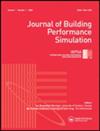食堂排队用餐场景的气溶胶传播及防控措施效果
IF 2.3
4区 工程技术
Q2 CONSTRUCTION & BUILDING TECHNOLOGY
引用次数: 0
摘要
本研究调查了食堂排队和用餐场景下的气溶胶传播情况,并探讨了控制措施的有效性。采用改进的Wells-Riley方程计算感染风险。在拥挤排队的情况下,很难稀释呼出的气溶胶,因为排队位置的更换增加了交叉感染的风险。线性队列和交叉队列感染风险最高,分别为1.16%和1.08%。缩短排队时间,增加隔离距离,佩戴口罩,可大大降低感染风险。在用餐情景中,增加乙酰胆碱对降低局部浓度的作用有限。靠近隔板顶部的排气孔可有效清除局部高浓度气溶胶。间歇性占用一个座位可以大大降低连续用餐之间的传播风险。这些发现将有助于加强对食堂传染病传播的控制。本文章由计算机程序翻译,如有差异,请以英文原文为准。
Aerosol transmission in queuing and dining scenarios in canteens and the effectiveness of control measures
This study investigates the aerosol transmission in queuing and dining scenarios in canteens and explores the effectiveness of control measures. An improved Wells-Riley equation is adopted to calculate the infection risk. The dilution of exhaled aerosols is difficult in the crowded queuing scenario, where the replacement of queuing positions increases the cross-infection risk. The highest infection risk is 1.16% and 1.08% for the linear-queue and cross-queue condition, respectively. Shortening the queuing duration, increasing the separation distance, and wearing masks can considerably reduce the infection risk. In the dining scenario, the effect of increasing ACH is limited on reducing the local concentration. An exhaust vent installed close to the top of the partition can effectively remove the local high-concentration aerosols. Intermittent occupation of a seat can considerably reduce the transmission risk between the consecutive dinners taking that seat. These findings should contribute to improved control of infectious transmission in canteens.
求助全文
通过发布文献求助,成功后即可免费获取论文全文。
去求助
来源期刊

Journal of Building Performance Simulation
CONSTRUCTION & BUILDING TECHNOLOGY-
CiteScore
5.50
自引率
12.00%
发文量
55
审稿时长
12 months
期刊介绍:
The Journal of Building Performance Simulation (JBPS) aims to make a substantial and lasting contribution to the international building community by supporting our authors and the high-quality, original research they submit. The journal also offers a forum for original review papers and researched case studies
We welcome building performance simulation contributions that explore the following topics related to buildings and communities:
-Theoretical aspects related to modelling and simulating the physical processes (thermal, air flow, moisture, lighting, acoustics).
-Theoretical aspects related to modelling and simulating conventional and innovative energy conversion, storage, distribution, and control systems.
-Theoretical aspects related to occupants, weather data, and other boundary conditions.
-Methods and algorithms for optimizing the performance of buildings and communities and the systems which service them, including interaction with the electrical grid.
-Uncertainty, sensitivity analysis, and calibration.
-Methods and algorithms for validating models and for verifying solution methods and tools.
-Development and validation of controls-oriented models that are appropriate for model predictive control and/or automated fault detection and diagnostics.
-Techniques for educating and training tool users.
-Software development techniques and interoperability issues with direct applicability to building performance simulation.
-Case studies involving the application of building performance simulation for any stage of the design, construction, commissioning, operation, or management of buildings and the systems which service them are welcomed if they include validation or aspects that make a novel contribution to the knowledge base.
 求助内容:
求助内容: 应助结果提醒方式:
应助结果提醒方式:


